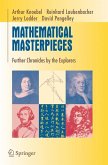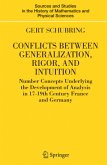The book is the first English translation of John Wallis's Arithmetica Infinitorum (1656), a key text on the seventeenth-century development of the calculus. Accompanied with annotations and an introductory essay, the translation makes Wallis's work fully available for the first time to modern readers. It shows how Wallis drew on some of the most important new ideas from the preceding twenty years, and took them forward to lay the foundations on which Newton was to build. Above all, the book displays the crucial mid-seventeenth-century shift from geometry to arithmetic and algebra as the primary language of mathematics.
Aus den Rezensionen: "... Die vorliegende ... Übersetzung ins Englische legt eines der wichtigsten und einflussreichsten Bücher des vor-Newtonschen Zeitalters in unsere Hände. Ohne Zweifel hat Arithmetica Infinitorum den Weg zur Fluxionenrechnung geebnet und muss daher als Werk von unschätzbarem Wert für historisch und mathematisch interessierte Leser eingeschätzt werden. ... Jeder historisch interessierte Mathematiker - Analytiker allenthalben - sollte dieses Buch griffbereit haben!" (Thomas Sonar, Aus der Geschichte der Analysis und der numerischen Mathematik, in: Mathematische Semesterberichte, 2005, Vol. 52, Issue 1, S. 91 ff.)
From the reviews:
"John Wallis (1616-1703) was the most influential mathematician in England ... . in his Arithmetica infinitorum (Arithmetic of Infinites), he extended traditional algebra of finite numbers and symbols ... . The translator, Dr. Jacqueline Anne Stedall, has already accomplished important research on John Wallis and his mathematics and thus is ideally qualified for both the translation and a scholarly introduction and explanatory notes. She also supplies a glossary, a bibliography, and an index, while figures and tables are reproduced as facsimiles from the original edition." (Christoph J. Scriba, SIAM Review, Vol. 47 (2), 2005)
"The author has done a superb job with the translation and accompanying introduction. Her expertise with the subject is readily apparent. She has rendered a valuable service to the mathematical community with this English translation of Arithmetica infintorum. One can sense the anticipation and excitement Newton must have felt upon first reading the work." (James J. Tattersall, Mathematical Reviews, 2005e)
"Jackie Stedall is amazing. ... here is her translation of John Wallis's famous Arithmetic of Infinitesimals (Arithmetica Infinitorum, first published in 1656). Thank you, Jackie; please never stop. Wallis's subtitle gives a good summary of what the book is about: 'A New Method of Inquiring into the Quadrature of Curves, and other more difficult mathematical problems'. ... Stedall's translation gives us access once again to this fascinating book, and her introduction helps us understand its place in history. Not to be missed." (Fernando Q. Gouvêa, MathDL, December, 2004)
"This is an English translation of John Wallis's famous Arithmetica infinitorum of 1656, a milestone in the prehistory of the calculus, whose influence on Newton was important. The translation preceded by a historical introduction recalling Wallis mathematical contributions and the genesis of his mostfamous book. ... It is a very useful addition to the literature about the history of calculus." (Jean Mawhin, Bulletin of the Belgian Mathematical Society, Vol. 12 (2), 2005)
"This book is famed above all for its infinite product for p, which duly appears among the final 'propositions'; and for this reason it is often regarded as a study of the quadrature of the circle. In fact it has a broader remit ... relationships between arithmetic and geometry, and between discrete and continuous magnitude, especially in connection with quantitative properties of various classical curves, surfaces and solids. ... This volume belongs to considerable recent efforts on English mathematics during the 17th century." (I. Grattan-Guinness, The Mathematical Gazette, Vol. 89 (515), 2005)
"To the modern reader the 'Arithmetica infinitorum' reveals much that is of historical and mathematical interest, not least the mid seventeenth-century tension between classical geometry on the one hand, and arithmetic and algebra on the other. Newton was to take up Wallis's work and transform it into mathematics that has become part of the mainstream, but in Wallis's text we see what we think of as modern mathematics still struggling to emerge. ... a relevant text even now for students and historians of mathematics alike." (Zentralblatt für Didaktik der Mathematik, January, 2005)
"John Wallis (1616-1703) was the most influential mathematician in England ... . in his Arithmetica infinitorum (Arithmetic of Infinites), he extended traditional algebra of finite numbers and symbols ... . The translator, Dr. Jacqueline Anne Stedall, has already accomplished important research on John Wallis and his mathematics and thus is ideally qualified for both the translation and a scholarly introduction and explanatory notes. She also supplies a glossary, a bibliography, and an index, while figures and tables are reproduced as facsimiles from the original edition." (Christoph J. Scriba, SIAM Review, Vol. 47 (2), 2005)
"The author has done a superb job with the translation and accompanying introduction. Her expertise with the subject is readily apparent. She has rendered a valuable service to the mathematical community with this English translation of Arithmetica infintorum. One can sense the anticipation and excitement Newton must have felt upon first reading the work." (James J. Tattersall, Mathematical Reviews, 2005e)
"Jackie Stedall is amazing. ... here is her translation of John Wallis's famous Arithmetic of Infinitesimals (Arithmetica Infinitorum, first published in 1656). Thank you, Jackie; please never stop. Wallis's subtitle gives a good summary of what the book is about: 'A New Method of Inquiring into the Quadrature of Curves, and other more difficult mathematical problems'. ... Stedall's translation gives us access once again to this fascinating book, and her introduction helps us understand its place in history. Not to be missed." (Fernando Q. Gouvêa, MathDL, December, 2004)
"This is an English translation of John Wallis's famous Arithmetica infinitorum of 1656, a milestone in the prehistory of the calculus, whose influence on Newton was important. The translation preceded by a historical introduction recalling Wallis mathematical contributions and the genesis of his mostfamous book. ... It is a very useful addition to the literature about the history of calculus." (Jean Mawhin, Bulletin of the Belgian Mathematical Society, Vol. 12 (2), 2005)
"This book is famed above all for its infinite product for p, which duly appears among the final 'propositions'; and for this reason it is often regarded as a study of the quadrature of the circle. In fact it has a broader remit ... relationships between arithmetic and geometry, and between discrete and continuous magnitude, especially in connection with quantitative properties of various classical curves, surfaces and solids. ... This volume belongs to considerable recent efforts on English mathematics during the 17th century." (I. Grattan-Guinness, The Mathematical Gazette, Vol. 89 (515), 2005)
"To the modern reader the 'Arithmetica infinitorum' reveals much that is of historical and mathematical interest, not least the mid seventeenth-century tension between classical geometry on the one hand, and arithmetic and algebra on the other. Newton was to take up Wallis's work and transform it into mathematics that has become part of the mainstream, but in Wallis's text we see what we think of as modern mathematics still struggling to emerge. ... a relevant text even now for students and historians of mathematics alike." (Zentralblatt für Didaktik der Mathematik, January, 2005)








